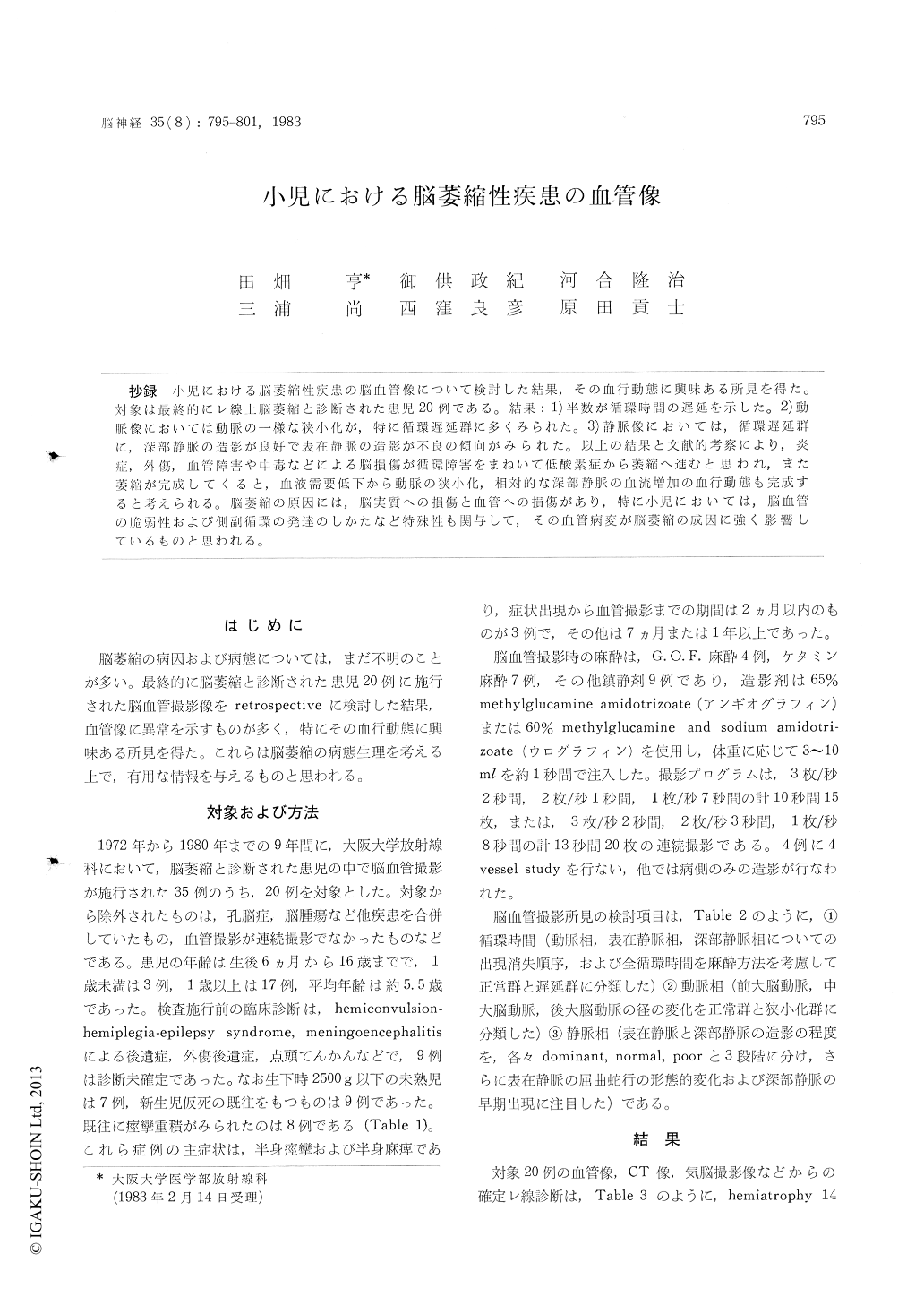Japanese
English
- 有料閲覧
- Abstract 文献概要
- 1ページ目 Look Inside
抄録 小児における脳萎縮性疾患の脳前管像について検討した結果,その血行動態に興味ある所見を得た。対像は最終的にレ線上脳萎縮と診断された患児20例である。結果:1)半数が循環的時間の遅延を示した。2)動脈像においては動脈の一様な狭小化が,特に循環遅延群に多くみられた。3)静脈像においては,循環遅延群に,深部静脈の造影が良好で表在静脈の造影が不良の傾向がみられた。以上の結果と文献的考察により,炎症,外傷,血管障害や中毒などによる脳損傷が循環障害をまねいて低酸素症から萎縮へ進むと思われ,また萎縮が完成してくると,血液需要低下から動脈の狭小化,相対的な深部静脈の血流増加の血行動態も完成すると考えられる。脳萎縮の原因には,脳実質への損傷と血管への損傷があり,特に小児においては,脳血管の脆弱性および側副循環の発達のしかたなど特殊性も関与して,その血管病変が脳萎縮の成因に強く影響しているものと思われる。
Angiographic findings of the cerebral atrophy in children are discussed. Cerebral angiographies were performed on 20 patients, ranging from 6 months to 16 years of age. Their clinical diagnoses were H-H-E syndrome (4 cases), sequelae of meningoencephalitis (2), sequelae of head trauma (3), infantile spasms (2) and others (9). Final radio-logical diagnoses of these cases were hemiatrophy (14 cases), generalized atrophy (2) and focal atrophy (4). Circulation time, caliber of arteries, degree of opacification in cortical and deep veins and early filling of deep veins were investigated on angiogram.
Slow circulation of cerebral blood flow was shown in 10 cases and normal circulation in 10 cases. Arterial narrowing was observed more frequently in slow circulation group. In cases with hemiatrophy, small caliber of the middle cerebral arteries and slow circulation on the atrophic hemisphere were demonstrated, but no abnorma-lity on the normal side. Deep veins were promi-nently opacified in cases which showed poor cortical veins, the other way cortical veins were prominent in cases which showed poor visualiza-tion of deep veins. Cortical veins and deep veins may compensate each other in cerebral venous drainage. In most cases of slow circulation, dominant opacification of deep veins were visua-lized and these veins already appeared in arterial phase, but cortical veins had a tendency of poor opacification. These venous drainage patterns are similar to those of Sturge-Weber syndrome. Causes of these vascular changes are unknown. But they may play an important role in cerebral atrophic disorders. In our opinion, both brain substance and cerebral vessels may be damaged in pediatric atrophic cerebral disorders and circulation becomes slow. Blood flow is redistributed and a large fraction is directed to deep veins. Anoxia and impairment of metabolism due to hemodynamic stasis might well be able to cause cerebral atrophy. In children the fragility of cerebral vessels and abundant blood flow circulation to basal ganglia may be important. It is thought that slow circula-tion, arterial narrowing and early filling of deep veins are important findings on angiograms of the atrophic cerebral disorders.

Copyright © 1983, Igaku-Shoin Ltd. All rights reserved.


